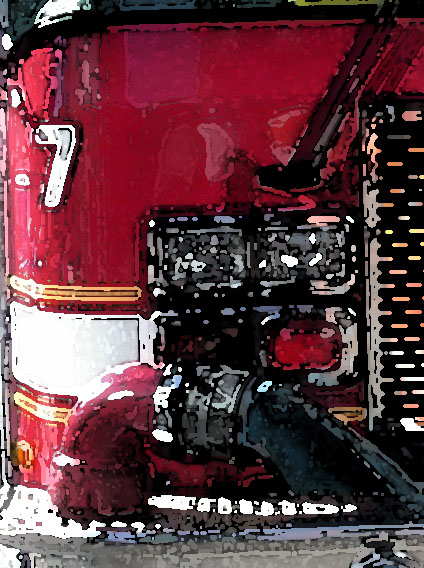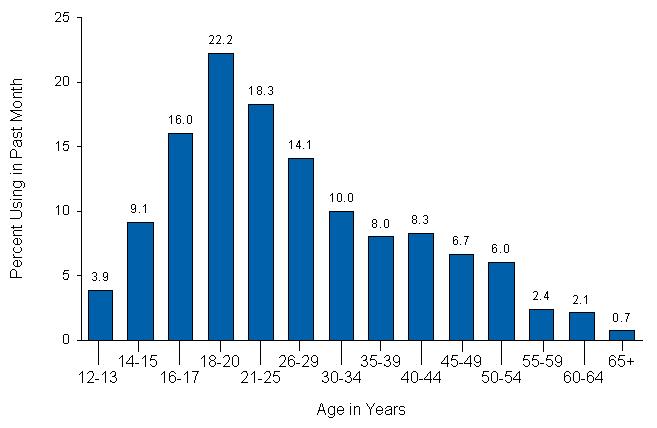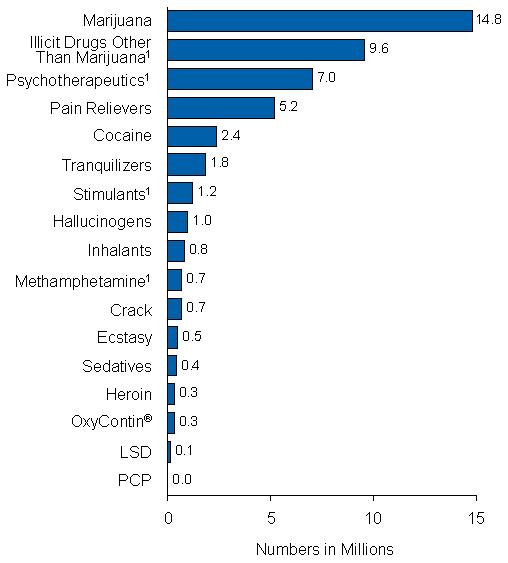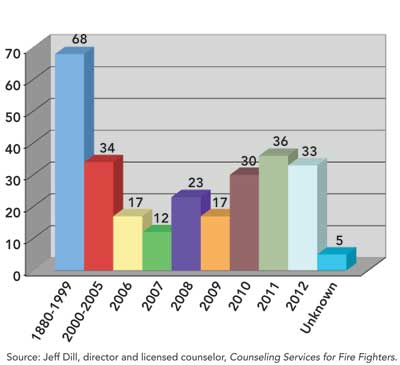Firefighter and First Responder Alcohol and Drug Issues Part I
First of 4 parts originally presented in an invited panel presentation to Gainesville Fire and Rescue, 2013. The article has been updated 7/31/2023
 by Ernest J. Bordini, Ph.D.Clinical Psychology Associates of North Central Florida, by Ernest J. Bordini, Ph.D.Clinical Psychology Associates of North Central Florida,
2121 NW 40th Terr. Suite B, Gainesville, FL 32605 (352) 336-2888
This article discusses alcohol and prescription drug problems in firefighters and first responders, contributors of stress and PTSD, and concerns about suicide rates. The second part of this series describes indicators and behavioral signs of alcohol or drug intoxication, impairment and after-effects. A list of educational materials, resources, websites, and crisis lines for firefighters, law enforcement officers, and other first responders comprises the third part of this series. The final part of the series involves a brief presentation of treatment principals in alcohol and substance use disorders and states of treatment readiness and action.
General Facts and Discussion about Alcohol and Drug Abuse, Post Traumatic Stress and Suicide in First Responders:
For the first time in 2009 drugs caused more deaths (37,485) than motor vehicle accidents. That was double the rate of drug-related deaths in 1999. A steep rise in deaths from overdoses of prescription narcotics contributes to this ongoing trend. According to the National Institute on Drug Abuse (NIDA), more than 106,000 persons in the U.S. died from drug-involved overdose in 2021, including illicit drugs and prescription opioids. Overall, drug overdose deaths rose from 2019 to 2021. The rate of drug overdose deaths involving natural and semisynthetic opioids, which include drugs such as oxycodone and hydrocodone, increased on average by 13% per year from 1999 to 2009 and by 3% per year from 2009 to 2016. Deaths involving synthetic opioids other than methadone (primarily fentanyl) continued to rise with 70,601 overdose deaths reported in 2021.
As the following graph (SAMSHA, 2006) demonstrates, peak ages of use involve late adolescence and early adulthood.
Historically, the most frequently abused drug was marijuana (SAMHSA, 2006), with prescription psychiatric medication and pain relievers coming in 3rd and 4th in terms of numbers of people of people abusing within the past month. According to Statista, the number of people in the U.S. who have used marijuana in the past year has been steadily increasing from approximately 28.7 million people in 2009 who used within the past year to approximately 52.5 million people in 2021. .

Approximately 75% of illegal drugs are consumed by people that are employed. Ten percent of that drug use is believed to occur in the work-place. Half of that is alcohol-related. Both on-duty and off-duty alcohol and drug abuse impact on workplace safety. Pilot judgment errors have been shown to persist 14 hours after alcohol abuse. Individuals who abuse alcohol or drugs are 4 times more likely to be injured at work. 
Alcohol is typically the substance most abused by public safety workers. Approximately 9.1 percent of workers in a group that includes firefighters reported heavy alcohol use in the previous month. The rate of alcohol use in the protective service category was slightly above the national average. Firefighters and law enforcement workers had the lowest rate of illicit drug use of any group of workers, with 1.5 percent reporting drug use in the past month (Source: The Party is Over; Emergency Vehicle Response: http://www.emergencyvehicleresponse.com/news/fullstory/newsid/123015 ).
The US Firefighters Association (USFA) estimates that as many as 10% of firefighters may be abusing drugs It estimates the threat of alcohol abuse among firefighters is more than double than that of the general population. Cincinnati’s National Institute for Occupational Safety and Health conducted a survey in 1993. It surveyed 145 firefighters and reported an estimate that up to 29% of firefighters have had problems with alcohol use and/or abuse. Thirty-seven percent of approximately fifty respondents to a Virginia Beach Fire Department survey reported their fire department lost one or more firefighters in the past two years due to alcohol abuse. When asked about successful interventions for dealing with alcohol and drug problems in the department the most common successful intervention (33%) was reported to be EAP programs.
There is a general relationship between stress, stressful occupations and substance abuse. Boxer and Wild (1993) found that more than 40% of firefighters were experiencing psychological distress. Almost 30% of them were experiencing problematic alcohol use. Studies report 30-50% of American men and a little more than 25% of women with PTSD have also had problems with drug abuse or dependence at some point during their lifetime. This was approximately double the rate of those individuals without PTSD (Brady et al 2004, Kessler et al 1995). There is an increased risk of PTSD in first responders. Research demonstrated FDNY was at higher risk for Alcohol problems after 9/11. http://www.firehouse.com/article/10466012/fdny-was-faced-with-alcohol-drug-abuse-problems-following-9-11. Research indicates that a combination of alcohol use and PTSD produces a tenfold increase in the risk of suicide (Violanti, 2004).
A useful quick measure for self-assessment on battle fatigue in soldiers or developing burnout and stress overload in firefighters, law enforcement and first responders is the ProQOL. This measure has sub-scales for compassion satisfaction, burnout, and compassion fatigue. It is commonly used to measure and monitor the negative and positive effects of helping others suffering traumatic experiences (Stamm, B. H., 2009, Professional quality of life: Compassion satisfaction and fatigue version 5 (ProQOL).
While alcohol and substance abuse are likely to be problems which may interfere with occupational performance and home life, the addiction of cigarette smoking also takes its toll on firefighter’s lives. USFA estimates that fire service loses approximately 1,800 members per year from smoking. Firefighters who smoke have higher level of risk from heart and lung diseases than do firefighters who do not smoke. Source [1]. Multiple attempts are often required to quit smoking.
Firefighter Suicides
 The number of firefighter fatalities has steadily decreased over the last 25 years, from a high of 171 in 1978 to a low of 75 in 1992. Despite this trend in absolute terms, approximately 100 firefighters are killed in the line of duty each year. In 2000, 102 firefighters died. (Source: USFA, 2000). The United States Fire Administration (USFA) reported 85 on duty firefighter fatalities in the United States as a result of incidents that occurred in 2010, a 6 percent decrease from the 90 fatalities reported for 2009. The number of firefighter fatalities has steadily decreased over the last 25 years, from a high of 171 in 1978 to a low of 75 in 1992. Despite this trend in absolute terms, approximately 100 firefighters are killed in the line of duty each year. In 2000, 102 firefighters died. (Source: USFA, 2000). The United States Fire Administration (USFA) reported 85 on duty firefighter fatalities in the United States as a result of incidents that occurred in 2010, a 6 percent decrease from the 90 fatalities reported for 2009.
According to the National Fallen Firefighters Foundation, there are between 100 and 200 firefighter deaths by suicide each year, double the rate of the general population.
Statistics about firefighter suicides are somewhat difficult to accurately obtain and there is variability in rates reported by varying sources. However, when compared to line of duty fatalities, it is clear that this remains an elevated risk for firefighters, as it is for other first responders such as law enforcement. Training in accessing and using preventative services, such as EAP and counseling services, should be considered as important as any other life-saving training or equipment.
Whether a firefighter, law enforcement officer, soldier of veteran, coping with the suicide of our warriors is difficult. See our website article on Difficult Losses.
More Articles in this Series
Firefighter and First Responder Alcohol and Drug Issues
Signs of alcohol or drug intoxication, impairment and after-effects
Resources, education, websites, and crisis lines for firefighters, law enforcement officers, and other first responders
Treatment principals and stages in treatment of alcohol and substance use disorders.
Related Articles on this Websites
Difficult Losses: Coping with Officer Suicides
References:
Fast Facts from Fire Department Safety Officer, 1st ed., International Fire Service Training Association.
Brady, K.T., Back, S.E., & Coffey, S.F. (2004). Substance abuse and posttraumatic stress disorder. Current Directions in Psychological Science, 13, 206-209.
CDC Injury Center Death Rate Maps & Graphs - Drug Overdose
CDC Drug Overdose Deaths in the United States, 1999–2019
Kessler, R.C., Sonnega, A., Bromet, E., Hughes, M., & Nelson, C.B. (1995). Posttraumatic stress disorder in the National Comorbidity Survey. Archives of General Psychiatry, 52, 1048-1060.
NIDA Drug Overdose Death Rates
Statista Past year marijuana users U.S. 2009-2021
Time Magazine U.S. Opioid Deaths Nearly Doubled Since 2009
Tull, M.T., Baruch, D., Duplinsky, M., & Lejuez, C.W. (in press).
Violanti, J. M. (2004). Predictors of police suicide ideation. Suicide and Life-Threatening Behavior, 34(3), 277–283.
About the Author:
 Ernest J. Bordini, Ph.D. is a licensed psychologist more than years of training and service in the evaluation and treatment of veterans, law enforcement officers and first responders. He is a member of the American Psychological Association Society of Military Psychology and a member of the City of Gainesville Violence Avoidance Task Force. In addition to his primary area of practice in clinical and forensic neuropsychology he has special interests in violence risk assessment, and officer-involved shootings. He has provided fitness for duty evaluations for government agencies, FDLE, corporations, medical facilities, school boards and other organizations. He has provided presentations, critical incident interventions, and team building to law enforcement and fire and rescue organizations. In his limited spare time he enjoys tactical and defensive firearm training and is an NRA certified Firearm Instructor. Ernest J. Bordini, Ph.D. is a licensed psychologist more than years of training and service in the evaluation and treatment of veterans, law enforcement officers and first responders. He is a member of the American Psychological Association Society of Military Psychology and a member of the City of Gainesville Violence Avoidance Task Force. In addition to his primary area of practice in clinical and forensic neuropsychology he has special interests in violence risk assessment, and officer-involved shootings. He has provided fitness for duty evaluations for government agencies, FDLE, corporations, medical facilities, school boards and other organizations. He has provided presentations, critical incident interventions, and team building to law enforcement and fire and rescue organizations. In his limited spare time he enjoys tactical and defensive firearm training and is an NRA certified Firearm Instructor.
|

